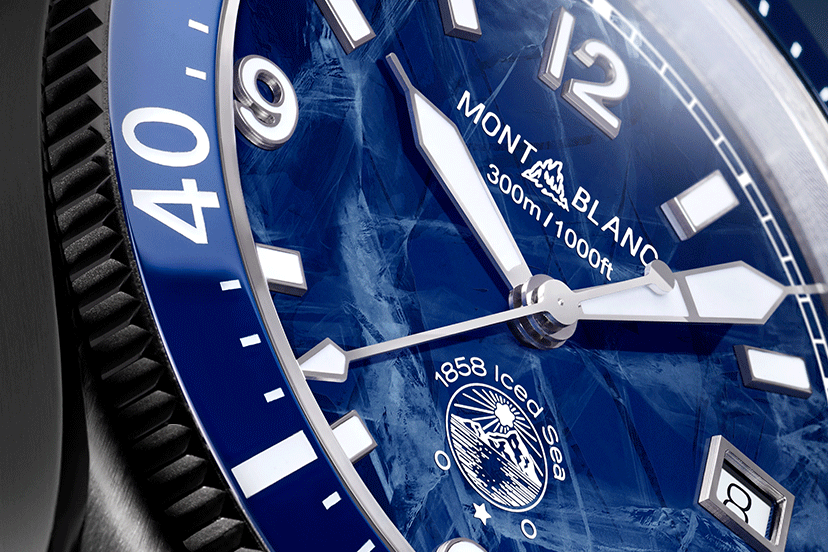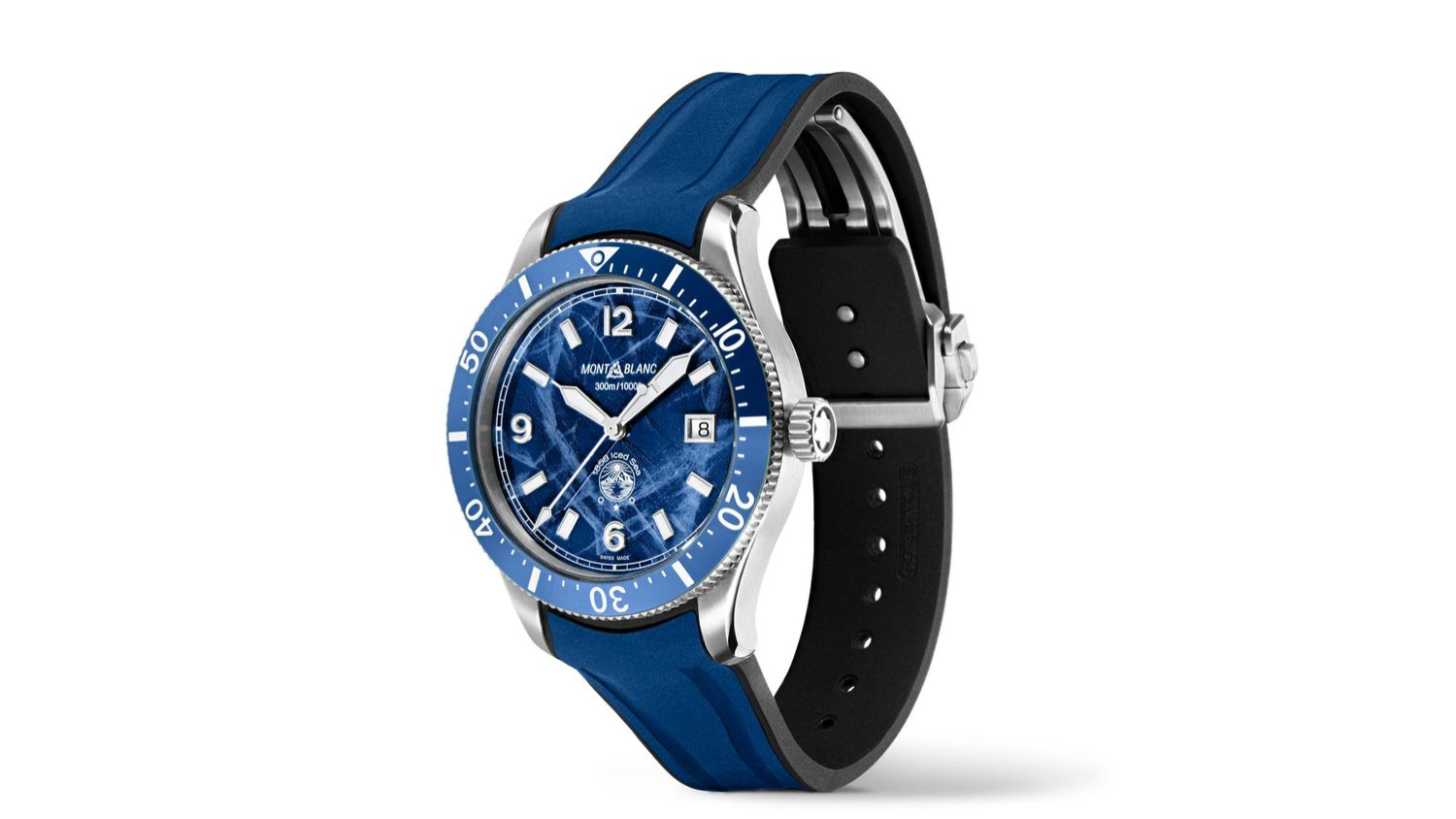That Montblanc routinely looks to nature and the spirit of exploration for inspiration for its watches is well known. Last year saw the debut of the 1858 Geosphere Limited Edition, inspired by explorer Reinhold Messner’s 2004 solo trek of nearly 2,000 kms across the Gobi Desert. The watch featured a rocky terrain colour scheme through a satin-finished bronze case, a bi-directional, brown, ceramic bezel, and a smoked brown and beige lacquered dial. In 2020, the Geosphere had appeared in a blue variant, evoking the colours of glaciers, ice, and snowy mountains; it was a tribute to the seven major mountain-climbing summits of the world. In 2019, the theme of the brand’s releases at the now defunct Salon International de la Haute Horlogerie was the spirit of exploration and nature itself—several watches in khaki-green and NATO straps saw the light of day. So it shouldn’t come as a surprise that in creating its newest milestone watch, Montblanc once again turned to nature. The 41mm stainless-steel 1858 Iced Sea Automatic Date (Ref 129369), Montblanc's first diver’s watch, is inspired by the striking beauty of the Mer de Glace (Sea of Ice), one of the biggest glaciers of the Mont Blanc massif, a mountain range in the Alps that extends across France, Italy, and Switzerland.

The influence of the unique beauty of the Mer de Glace is clearly visible on the dial. The glacier is known for its iced texture of interlocked crystals, and gets a blue hue thanks to the inclusion of air bubbles in the ice. It is this pattern and colour that the watchmaker has recreated on the dial.
And it’s no mean feat. Imagine trying to create the depth of a glacier, the natural pattern of its crystals, and the luminosity and colour of ice on a .44mm thick dial. Montblanc achieved this through an ancient crafting technique called gratté boisé, which involves polishing and lacquering. The brand worked with a long-term supplier to execute this technique, through a process that is exclusive to Montblanc. “In a technical feat, our dial makers have created the illusion of looking into the depths of a glacier, employing an almost-forgotten ancestral technique called gratté boisé as the base,” says
Laurent Lecamp, managing director, Montblanc Montre. “With this technique, we have created something that is both sustainable and innovative. The result captures Montblanc’s spirit of exploration, both in terms of the adventures the watches are made for, and the way in which they are designed and created,” he adds.
Holding the watch and getting the light to hit the charcoal-blue dial at different angles brings out the different gradations and ‘frozen crystals’, and thereby, depth of design.
The charcoal-blue dial is one of three variants that the brand has introduced. Ref 129371 features a charcoal-black dial, inspired by black ice formed in the absence of, or due to the presence of deposits of volcanic ash, commonly seen in the polar regions. Ref 129765 is charcoal green, and is reminiscent of the green ice typically seen in Antarctica—it is a result of the presence of microscopic snow algae blooms in the ice.
With such attention to design, it is easy to momentarily forget that, at its very core, the 1858 Iced Sea Automatic Date is a tool watch, Montblanc’s first diver’s watch at that. And it’s been a long time coming. “Montblanc always had the legitimacy to work on divers’ watches, but there hasn’t been a chance before,” explains Lecamp. “Montblanc has always been a leader in sports watches, which also means diver’s watches. With this timepiece, we connected the word ‘sea’ with our reputation in the world of sports watches and created something that is very well received by our end customers, because it perfectly integrates the highest ISO 6425 standards.”
For Lecamp, this was a personal project—creating a watch that had a connection with ice is something he always wanted to do. “I actually started envisioning this project even before I joined Montblanc,” he says. “I love nature. I run marathons on snow, and during one of my runs I thought it would be great to create a watch that had a connection with ice. Then, life connected the dots and I ended up at Montblanc. This is where I knew the idea could come to life.”

The 1858 Iced Sea Automatic Date certainly makes an impression on the wrist. There is a fair amount of heft in the stainless-steel bracelet version (there are rubber strap options as well), and the watch has a height of 12.9mm. The dial features a mix of rhodium-coated and blue luminescent, applied Arabic numerals and baton indexes for the hour markers, while the hour and minute hands are rhodium-coated and blue luminescent in the cathedral style. A date window rests at 3 o’clock, and the dial is circled by a chemin de fer minute track. At 12 o’clock rests the Montblanc logo, under which the water resistance of the watch (300m/1,000ft) is mentioned. At 6 o’clock, one sees ‘1858 Iced Sea’ resting above
the six-point Montblanc star shining over mountains and glacial lakes. The dial is topped by a crystal sapphire that is anti-reflective both inside and outside.
The bezel is knurled, ceramic, and unidirectional, with shot blasting in bi-coloured blue; turning it creates a strong ratcheting sound. The dot at 12 also has blue Super-LumiNova®. The crown is stainless steel with polished and fluted finishing, and the Montblanc emblem in relief. Turn the watch over and you see a closed caseback with a lasered and engraved 3D relief of an iceberg and a scuba diver exploring glacial waters.

In keeping with the aesthetic of a sturdy steel sports watch, the case features polished and satinated finishing. The lugs are curved, and between them hold the option of interchangeable straps. Montblanc has paid special attention to the bracelet design. The stainless-steel, v-shaped bracelet has a tapering style—beginning at 20mm and going down to 16mm—and can be adjusted for length easily. Secured by a double deployant buckle with the Montblanc branding, the bracelet certainly adds flair to the piece, and once again points to the attention paid to elegance. Accompanying the watch is the option of rubber straps.
The watch is powered by the automatic MB 24.17/SW200, which has a power reserve of approximately 38 hours and a 4Hz frequency. The movement is based on the Sellita SW200-1, used by Montblanc in several of its Heritage models. “It is an excellent calibre in terms of precision and reliability, which is what you’d expect from a diving watch,” says Lecamp.

Montblanc has naturally taken care to get its first diver’s watch to meet the highest standards of robustness, endurance, and precision. To do this, it has ensured that the watch complies with ISO 6425 norms. The exacting standards of the norms identify the minimum requirement for a watch designed to withstand diving in waters at depths of at least 100 metres, and at a very basic level differentiate between pieces that one can actually dive with versus ones that have a dive watch aesthetic. Criteria in its long check-list include water pressure tests, and tests that check the watch’s resistance to magnetic fields and condensation, among others.

In addition to this certification, each timepiece has undergone the Montblanc Laboratory 500 Hour Test, a rigorous testing procedure that measures watches for utmost precision. “The timepieces undergo a variety of controls and checks over a period of 500 hours: Daily wear and tear, water resistance, numerous settings and re-settings, different climatic conditions, as well as a check of all their specific functions,” explains Lecamp. “It is a demanding and tough procedure that guarantees the functionality of even the most technically complex features.” Each watch that passes the Montblanc Laboratory Test 500 is issued an individual test certificate and only then released for delivery.
That Montblanc’s repertoire now has a diver’s watch strengthens both its portfolio and its ethos of exploration. But the fact that the brand has created a debut watch that places equal emphasis on elegance and precision while paving the way for its future diver’s models, reaffirms why Montblanc continues to be a coveted watchmaker.
Images: Courtesy Montblanc
This story first appeared in the July-Sept 2022, 10th-anniversary issue of WatchTime India. This issue is on stands now. To subscribe to the print edition, click here. 





















